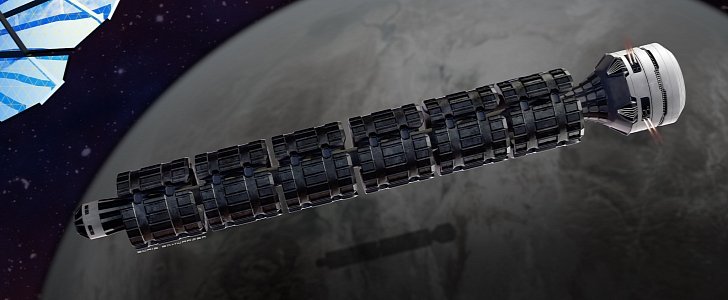Goodbye, year-long mission to Mars! Farewell, lengthy and dangerous expedition to the Moon! Welcome, yet undreamed city-breaks to the Outer Planets! Introducing the Solar Express, the world's first space-train-that-never-stops.
Currently, getting to one of the other celestial bodies in our solar system is quite an undertaking. The technology being used alone costs as much money as many of our planet's country's produce, and the results and lengthy and at times questionable.
But what it you could reach the Moon and come back in under four hours? Or Mars, in just two days? And you could, says Charles Bombardier, a Canadian out-of-the-box thinker, if you would have the Solar Express at your disposal.
The so-called train is consists of a series of six aligned cylinders, 50 meters in length each. It would first accelerate with rocket boosters, but then there would be no stopping it. It would go on and on forever, using the force of gravity to slingshot around planets or moons. That way, says the dreamer, the train will never require much fuel, nor the energy usually needed for acceleration or deceleration, remaining at a constant speed of 3,000 km/second (1,864 mph).
How can you get on and off of the thing if it never stops? Why, mathematics, of course. To get on, Mobile Cargo Bays (MCBs) or other spacecraft would be launched at such a time and place so that it would intersect the train's path. To get off, MCBs would be at such a time and place so that it would intersect the destination.
The train could be powered by solar arrays located along the train’s path, sending constant energy to it for day-to-day operations. Water for the crew, passengers and hydrogen fuel (needed for small course adjustments) could also come from the solar arrays across the train’s path.
This Canadian idea seems pretty simple and useful. We could probably build the damn thing next year if we wanted. The problem is we are nowhere near the technological level needed for all the infrastructure needed to operate this train. Huge solar arrays? Nope. Laser-transferred energy? Nope. Harvesting water from comets? Get real.
But what it you could reach the Moon and come back in under four hours? Or Mars, in just two days? And you could, says Charles Bombardier, a Canadian out-of-the-box thinker, if you would have the Solar Express at your disposal.
The so-called train is consists of a series of six aligned cylinders, 50 meters in length each. It would first accelerate with rocket boosters, but then there would be no stopping it. It would go on and on forever, using the force of gravity to slingshot around planets or moons. That way, says the dreamer, the train will never require much fuel, nor the energy usually needed for acceleration or deceleration, remaining at a constant speed of 3,000 km/second (1,864 mph).
How can you get on and off of the thing if it never stops? Why, mathematics, of course. To get on, Mobile Cargo Bays (MCBs) or other spacecraft would be launched at such a time and place so that it would intersect the train's path. To get off, MCBs would be at such a time and place so that it would intersect the destination.
The train could be powered by solar arrays located along the train’s path, sending constant energy to it for day-to-day operations. Water for the crew, passengers and hydrogen fuel (needed for small course adjustments) could also come from the solar arrays across the train’s path.
This Canadian idea seems pretty simple and useful. We could probably build the damn thing next year if we wanted. The problem is we are nowhere near the technological level needed for all the infrastructure needed to operate this train. Huge solar arrays? Nope. Laser-transferred energy? Nope. Harvesting water from comets? Get real.




